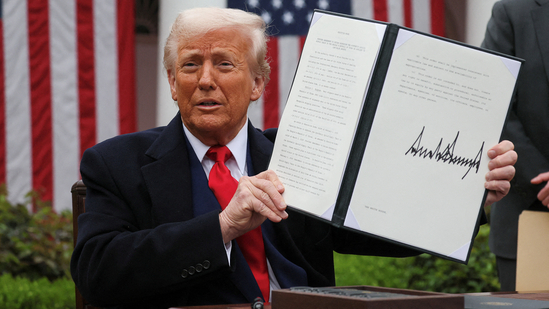Donald Trump's reciprocal tariffs: How will they impact Indian exports?
The reciprocal tariffs, with baselines of 10 per cent on all countries, were announced by Donald Trump from the White House on Wednesday.
US President Donald Trump slapped a “discounted” 26 per cent reciprocal tariff on goods from India entering the United States along with varying charges on other countries, raising trade barriers.

The reciprocal tariffs, with baselines of 10 per cent on all countries, were announced by Donald Trump from the White House on Wednesday, April 2, what the US President has termed as ‘Liberation Day’.
Also Read: Bitcoin, other cryptos fall after Trump tariffs kill investor risk appetite
Trump tariffs: Who will be most affected in India?
Close to $14 billion worth of electronics products and more than $9 billion worth of gems and jewellery are among the top sectors to be hit by the US tariffs, according to a report by news agency Reuters.
The White House said pharmaceutical products, which comprise nearly $9 billion worth of exports from India as per government data, and energy products are exempt under the latest round of reciprocal tariffs.
Though the 26 per cent tariff won't apply to auto parts and aluminium products, they will still attract the 25 per cent tariff which Trump had announced earlier.
In contras, the US previously had a sector-wide average tariffs on Indian goods from sectors like automobiles, gems and jewellery, chemicals and pharmaceuticals and electronic products, at 1.05 per cent, 2.12 per cent, 1.06 per cent, and 0.41 per cent, respectively, as per the report which cited data from the Global Trade Research Initiative.
Also Read: Tesla's quarterly sales plunge as backlash against Elon Musk grows
The retaliatory tariffs came about since the US has a $46 billion trade deficit with India.
The US imposes a 2.5 per cent tariff on passenger vehicle imports, while India imposes 70 per cent, the White House had said in a statement.
It added that apples are allowed to enter the US duty free, but India imposes a 50 per cent duty on US apples coming in to India, and that rice attracts only a 2.7 per cent levy in the US, but attracts 80 per cent tariffs in India.
The US also imposes a 0 per cent tariff in networking switches and routers, but India levies rates of 10-20 per cent, the statement added.
Also Read: Global stock markets dive as Donald Trump's reciprocal tariffs kick in, tech hit the worst
What's the outlook forward?
When Prime Minister Narendra Modi visited the US in February, the two nations had agreed to start talks leading towards an early trade deal to resolve the standoff on tariffs.
India may be open to cutting tariffs substantially for more than $23 billion worth of US goods, according to the report.






